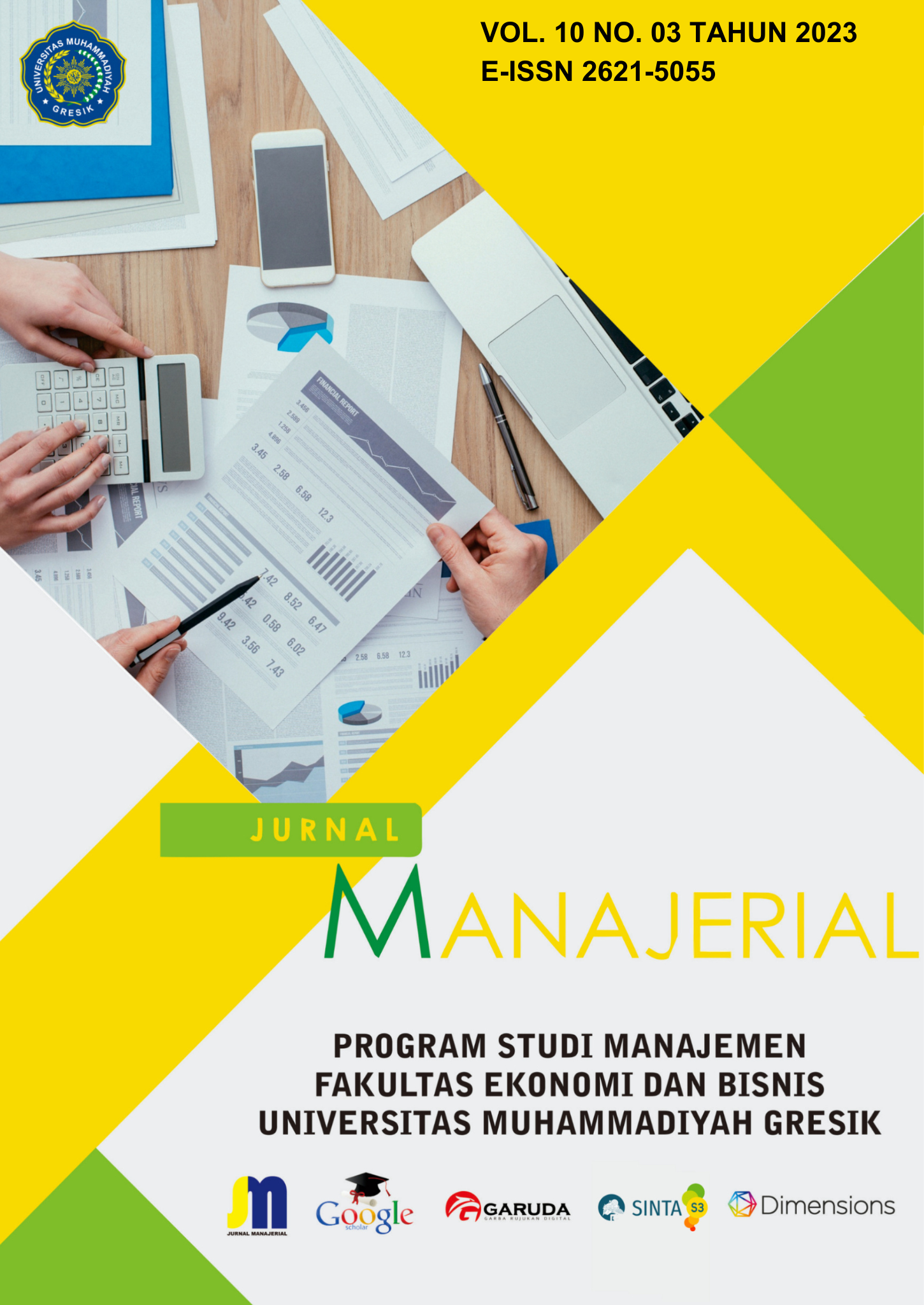Increasing Epistemic Value And Rate Through Flow Value Co-Creation Perspective Of Service-Dominant Logic Theory
DOI:
https://doi.org/10.30587/jurnalmanajerial.v10i03.5607Keywords:
Flow, Value, Co-Creation, Service, Dominant, LogicsAbstract
Background – Flow value co-creation is a psychological condition where a person feels pleasure in using a product or service. This concept starts with Service-Dominant Logic Theory (SDL) which indicates that SDL tends in the domain of marketing services.
Aim –This study aims to identify the mediation of Flow value co-creation (FVC) with Epistemic (EPV) and Rate (RT) variables.
Design / methodology / approach – This study describes the unaffected relationship between Epistemic values and Ratings mediated by the new concept of Flow value co-creation. The PLS-SEM equation engineering model uses the retrieval technique. This study involved a total of 286 Y generations of Shopee application users Y.
Findings – The results showed that Flow value co-creation increased Rate. Shopee application users especially the Y generation feel shared comfort.
Conclusion - The FVC relationship to RT has a logical impact in which the more comfortable, enjoyable, and safe using an application, the better the RT. The model can be assumed that Flow value co-creation can mediate the inconsistency of complex debates from previous studies regarding Epistemic Correlation (EPV) at Rate (RT).
Research implication – For startup makers in the form of applications to survive. First, updates for consumer users affect user enjoyment. Second, the evaluation of applications for target markets such as MSMEs and consumers in their use will have an impact on the market. Third, Flow value co-creation affects the stakeholders in improving application performance.
Limitations – The number of respondents is only in the Bantul area and is under 300 respondents, the development of variables such as the length of time the user is used, the frequency of applications used through advertisements.
References
Andreu, L., Sánchez, I., & Mele, C. (2010). Value co-creation among retailers and consumers: New insights into the furniture market. Journal of Retailing and Consumer Services, 17(4), 241–250. https://doi.org/10.1016/j.jretconser.2010.02.001
Arthur, W. B. (2009). The Nature of Technology: What it Is and How it Evolves. Free Press.
Aulia, S. A., Sukati, I., & Sulaiman, Z. (2016). A Review: Customer Perceived Value and its Dimension. Asian Journal of Social Sciences and Management Studies, 3(2), 150–162. https://doi.org/10.20448/journal.500/2016.3.2/500.2.150.162
Baik, A., Venkatesan, R., & Farris, P. (2014). Mobile Shopper Marketing: Assessing the Impact of Mobile Technology on Consumer Path to Purchase (pp. 1–25). https://doi.org/10.1108/S1548-643520140000011001
Beverungen, D., Breidbach, C. F., Poeppelbuss, J., & Tuunainen, V. K. (2019). Smart service systems: An interdisciplinary perspective. Information Systems Journal, 29(6), 1201–1206. https://doi.org/10.1111/isj.12275
Candan, B., Ünal, S., & Erciş, A. (2013). Analyzing the relationship between consumption values and brand loyalty of young people: a study on personal care products. Eur. J. Res. Edu., 1, 29–46.
Carlson, J., de Vries, N. J., Rahman, M. M., & Taylor, A. (2017). Go with the flow: engineering flow experiences for customer engagement value creation in branded social media environments. Journal of Brand Management, 24(4), 334–348. https://doi.org/10.1057/s41262-017-0054-4
Chen, Q., Feng, Y., Liu, L., & Tian, X. (2019). Understanding consumers’ reactance of online personalized advertising: A new scheme of rational choice from a perspective of negative effects. International Journal of Information Management, 44, 53–64. https://doi.org/10.1016/j.ijinfomgt.2018.09.001
Chen, S. C., & Raab, C. (2017). Construction and Validation of the Customer Participation Scale. Journal of Hospitality & Tourism Research, 41(2), 131–153. https://doi.org/10.1177/1096348014525631
Chopdar, P. Kr., Korfiatis, N., Sivakumar, V. J., & Lytras, M. D. (2018). Mobile shopping apps adoption and perceived risks: A cross-country perspective utilizing the Unified Theory of Acceptance and Use of Technology. Computers in Human Behavior, 86, 109–128. https://doi.org/10.1016/j.chb.2018.04.017
Corodeanu, D.-T. A. (2015). Consumer’s Protection from the Generation Y’s Perspective. A Research Based on Scenarios. Procedia Economics and Finance, 20, 8–18. https://doi.org/10.1016/S2212-5671(15)00041-6
Csikszentmihalyi, M. (2008). The psychology of optimal experience . Harper Collins.
Grönroos, C. (2008). Service logic revisited: who creates value? And who co‐creates? European Business Review, 20(4), 298–314. https://doi.org/10.1108/09555340810886585
Grover, V., & Kohli, R. (2012). Cocreating IT Value: New Capabilities and Metrics for Multifirm Environments. MIS Quarterly, 36(1), 225. https://doi.org/10.2307/41410415
Hair, J., Hollingsworth, C. L., Randolph, A. B., & Chong, A. Y. L. (2017). An updated and expanded assessment of PLS-SEM in information systems research. Industrial Management & Data Systems, 117(3), 442–458. https://doi.org/10.1108/IMDS-04-2016-0130
Hair Jr, Joe. F., Sarstedt, M., Hopkins, L., & Kuppelwieser, Volker. G. (2014). Partial least squares structural equation modeling (PLS-SEM). European Business Review, 26(2), 106–121. https://doi.org/10.1108/EBR-10-2013-0128
Hsiao, C.-H., Chang, J.-J., & Tang, K.-Y. (2016). Exploring the influential factors in continuance usage of mobile social Apps: Satisfaction, habit, and customer value perspectives. Telematics and Informatics, 33(2), 342–355. https://doi.org/10.1016/j.tele.2015.08.014
Hsieh, H.-Y. (2016). The Relationship among Consumer Value, Brand Image, Perceived Value and Purchase Intention- A Case of Tea Chain Store in Tainan City. Proceedings of the Eighth Asia-Pacific Conference on Global Business, Economics, Finance and Banking (AP16Singapore Conference), 21–23.
Hunt, S. D., & Madhavaram, S. (2006). Teaching Marketing Strategy: Using Resource-Advantage Theory as an Integrative Theoretical Foundation. Journal of Marketing Education, 28(2), 93–105. https://doi.org/10.1177/0273475306288397
Kim, J. M., Kim, M., & Key, S. (2020). When profile photos matter: the roles of reviewer profile photos in the online review generation and consumption processes. Journal of Research in Interactive Marketing, 14(4), 391–412. https://doi.org/10.1108/JRIM-10-2019-0163
King, R. A., Racherla, P., & Bush, V. D. (2014). What We Know and Don’t Know About Online Word-of-Mouth: A Review and Synthesis of the Literature. Journal of Interactive Marketing, 28(3), 167–183. https://doi.org/10.1016/j.intmar.2014.02.001
Lamberton, C., & Stephen, A. T. (2016). A Thematic Exploration of Digital, Social Media, and Mobile Marketing: Research Evolution from 2000 to 2015 and an Agenda for Future Inquiry. Journal of Marketing, 80(6), 146–172. https://doi.org/10.1509/jm.15.0415
Mokyr, J. (2002). The Gifts of Athena: Historical Origins of the Knowledge Economy. Princeton University Press.
Mollen, A., & Wilson, H. (2010). Engagement, telepresence and interactivity in online consumer experience: Reconciling scholastic and managerial perspectives. Journal of Business Research, 63(9–10), 919–925. https://doi.org/10.1016/j.jbusres.2009.05.014
Ng, S. C., Plewa, C., & Sweeney, J. C. (2016). Professional Service Providers’ Resource Integration Styles (PRO-RIS). Journal of Service Research, 19(4), 380–395. https://doi.org/10.1177/1094670516662351
Nittala, S. S. S., Bharadwaj, S. S., Tripathi, S. S., & Seif, H. (2022). Service innovation enabled by Internet of Things and cloud computing – a service-dominant logic perspective. Technology Analysis & Strategic Management, 34(4), 433–446. https://doi.org/10.1080/09537325.2021.1903417
Novak, T. P., Hoffman, D. L., & Yung, Y.-F. (2000). Measuring the Customer Experience in Online Environments: A Structural Modeling Approach. Marketing Science, 19(1), 22–42. https://doi.org/10.1287/mksc.19.1.22.15184
Olawale, F., & Garwe, D. (2010). Obstacles to the growth of new SMEs in South Africa: A principal component analysis approach. African Journal of Business Management, 4(5), 729–738.
Palomba, F., Linares-Vasquez, M., Bavota, G., Oliveto, R., di Penta, M., Poshyvanyk, D., & de Lucia, A. (2015). User reviews matter! Tracking crowdsourced reviews to support evolution of successful apps. International Conference on Software Maintenance and Evolution (ICSME), 291–300. https://doi.org/10.1109/ICSM.2015.7332475
Pelet, J.-É., Ettis, S., & Cowart, K. (2017). Optimal experience of flow enhanced by telepresence: Evidence from social media use. Information & Management, 54(1), 115–128. https://doi.org/10.1016/j.im.2016.05.001
Pietro, L., Edvardsson, B., Reynoso, J., Renzi, M. F., Toni, M., & Guglielmetti Mugion, R. (2018). A scaling up framework for innovative service ecosystems: lessons from Eataly and KidZania. Journal of Service Management, 29(1), 146–175. https://doi.org/10.1108/JOSM-02-2017-0054
Polo Peña, A. I., Frías Jamilena, D. M., & Rodríguez Molina, M. Á. (2017). The effects of perceived value on loyalty: the moderating effect of market orientation adoption. Service Business, 11(1), 93–116. https://doi.org/10.1007/s11628-016-0303-8
Prebensen, N. K., Vittersø, J., & Dahl, T. I. (2013). Value Co-Creation Significance Of Tourist Resources. Annals of Tourism Research, 42, 240–261. https://doi.org/10.1016/j.annals.2013.01.012
Sabillah, A., Widiyanesti, S., & Goniah, G. (2021). Pengaruh Dimensi Web Quality Terhadap Kepuasan Pelanggan Pada Shopee Di Bandung.
Singh, S., Zolkepli, I. A., & Cheah, W. K. (2018). New Wave in Mobile Commerce Adoption via Mobile Applications in Malaysian Market: Investigating the Relationship Between Consumer Acceptance, Trust, and Self Efficacy. International Journal of Interactive Mobile Technologies (IJIM), 12(7), 112. https://doi.org/10.3991/ijim.v12i7.8964
Tabachnick, B. G., & Fidell, L. S. (2012). Using Multivariate Statistics (6th Edition). person.
Vargo, S. L., & Lusch, R. F. (2004). Evolving to a New Dominant Logic for Marketing. Journal of Marketing, 68(1), 1–17. https://doi.org/10.1509/jmkg.68.1.1.24036
Vargo, S. L., & Lusch, R. F. (2016). Institutions and axioms: an extension and update of service-dominant logic. Journal of the Academy of Marketing Science, 44(1), 5–23. https://doi.org/10.1007/s11747-015-0456-3
Wu, I.-L., Chen, K.-W., & Chiu, M.-L. (2016). Defining key drivers of online impulse purchasing: A perspective of both impulse shoppers and system users. International Journal of Information Management, 36(3), 284–296. https://doi.org/10.1016/j.ijinfomgt.2015.11.015
Wu, J.-J., Shu-Hua, C., & Kang-Ping, L. (2017). Why should I pay? Exploring the determinants influencing smartphone users’ intentions to download paid app. Telematics and Informatics, 34(5), 645–654. https://doi.org/10.1016/j.tele.2016.12.003
Wu, Y., & Wu, J. (2016). The Impact of User Review Volume on Consumers’ Willingness-to-Pay: A Consumer Uncertainty Perspective. Journal of Interactive Marketing, 33, 43–56. https://doi.org/10.1016/j.intmar.2015.11.001
Xiao, G., & Kim, J.-O. (2009). The investigation of Chinese consumer values, consumption values, life satisfaction, and consumption behaviors. Psychology and Marketing, 26(7), 610–624. https://doi.org/10.1002/mar.20291
Zhang, C.-B., Li, Y.-N., Wu, B., & Li, D.-J. (2017). How WeChat can retain users: Roles of network externalities, social interaction ties, and perceived values in building continuance intention. Computers in Human Behavior, 69, 284–293. https://doi.org/10.1016/j.chb.2016.11.069
Zhang, H., Lu, Y., Gupta, S., & Zhao, L. (2014). What motivates customers to participate in social commerce? The impact of technological environments and virtual customer experiences. Information & Management, 51(8), 1017–1030. https://doi.org/10.1016/j.im.2014.07.005






























 P-ISSN: 2354-8592 __ E-ISSN: 2621-5055
P-ISSN: 2354-8592 __ E-ISSN: 2621-5055 
